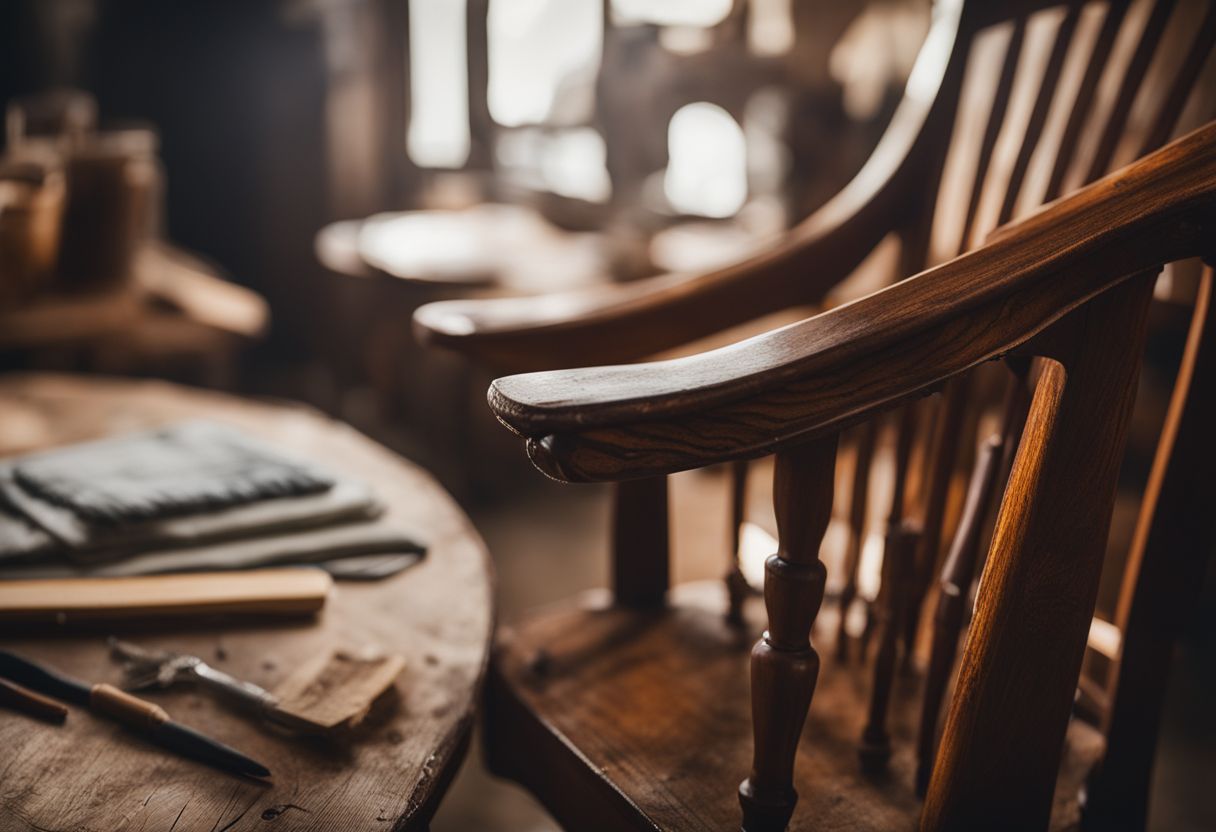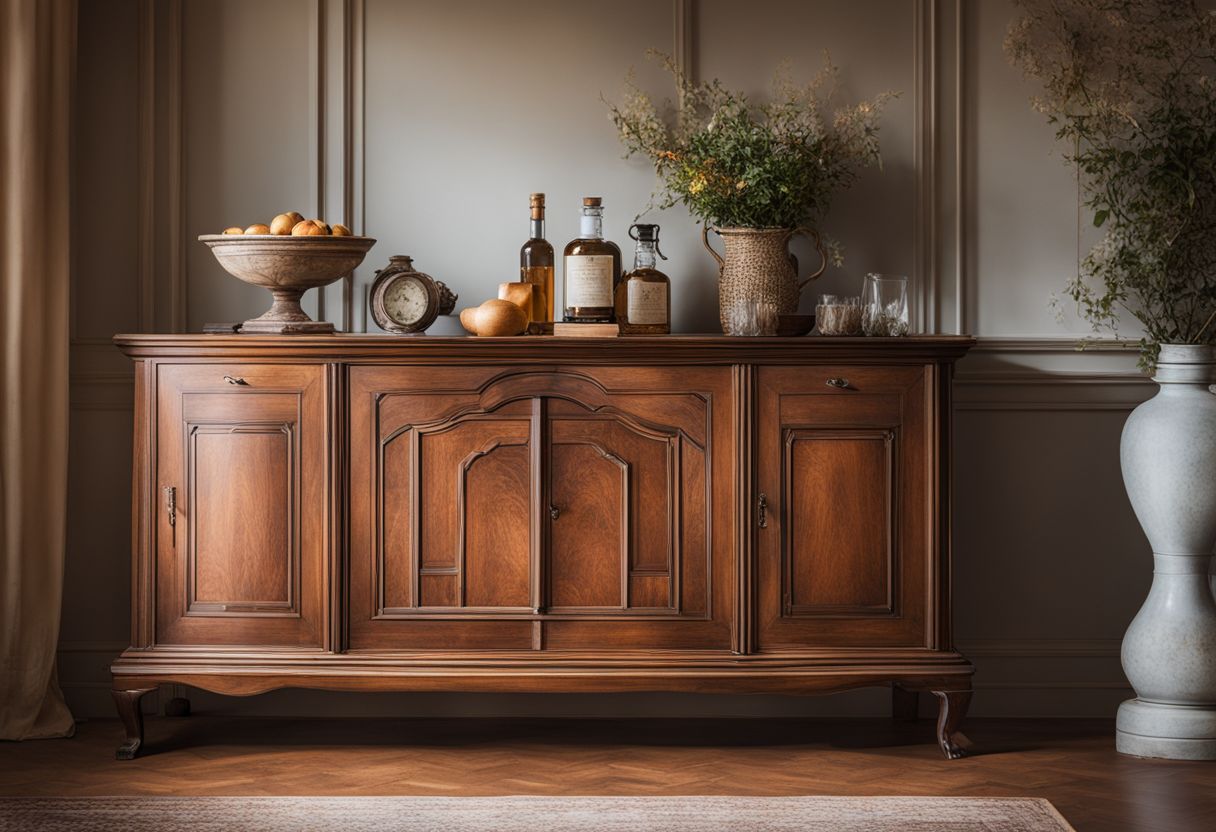What Not to Do to Antique Furniture at Home: Avoid These Common Mistakes
There’s something truly special about owning a piece of antique furniture – it’s like holding a tangible piece of history right in your living room! But, as many of us have learned the hard way, maintaining their elegance and value can sometimes feel like an uphill battle.
Just like you, despite my best intentions, I’ve unintentionally caused harm to my cherished antiques with misguided cleaning or restoration attempts. Not one to be deterred, I took it upon myself to learn what not to do to antique furniture at home, and how best to care for these beautiful artifacts from yesteryears.
So through extensive research and some hands-on experience (a few trials and errors later), I’ve put together invaluable insights on how you can effectively restore and preserve your ageless treasures right at home.
Delve into this handy guide where you will uncover how small tweaks in cleaning methods or even placement choices can significantly enhance the lifespan and lustre of your beloved antiques.
Key Takeaways
- Don’t skip the sanding process when restoring antique wood furniture. Proper sanding is important to achieve smooth and even results.
- Use the right type of sandpaper to avoid causing damage to your furniture. Choose the correct grit size for each stage of restoration.
- Clean antique furniture only as needed using gentle methods. Avoid using wax, harsh chemicals, or excessive moisture that can harm the wood and finishes.
- Mind where you place your antique furniture to protect it from accidental damage. Consider investing in a dehumidifier to maintain proper humidity levels and preserve its quality.
Understanding Antique Wood Restoration

One common mistake to avoid is skipping the sanding process when restoring antique wood furniture.
Common Mistakes to Avoid
I want to share some common mistakes to avoid while caring for antique wood furniture:
- Don’t skip the sanding process. This is very important. There’s a need for proper sanding to keep away from rough and imperfect results.
- Use the right type of sandpaper. Choosing the wrong kind can ruin your furniture.
- Avoid putting too few or too many coats of stain on your antique piece. The way you apply your stain can change how your furniture looks.
- Be careful with how you apply the stain, an uneven application should be avoided.
- Give your whole piece a good cleaning with vegetable – based oil soap and warm water, don’t just spot clean.
- Always keep in mind where you place it at home; location matters!
- Do not throw out any pieces; they all add value to the antique.
- Keep tabs on market demand for vintage furniture restoration services to avoid sales forecast errors.
Skipping the sanding process
Sanding is key in antique wood restoration. It takes off the old finish from your furniture. If you skip this, your work may not turn out right. The fresh paint or polish won’t stick well on the old layer.
Improper sanding can harm your valuable piece too. Using wrong grit size of sandpaper results in rough spots and scratches. So, pick correct sandpaper for a smooth and even look after restoring.
Using the correct sandpaper
Picking the right sandpaper makes a big change in wood refinishing. The wrong one can harm old furniture. It’s not wise to start with a very rough grit, it leaves deep scratches. A medium grit works best at first.
It will take off the old finish but not hurt the wood much. Later, use fine-grit papers to make it smooth and ready for new finish.
What Not to Do to Antique Furniture at Home: Cleaning Antique Furniture

To clean antique furniture, only clean as needed and be mindful of wear and patina. Avoid using wax, as it can build up over time and damage the wood. Instead, opt for a gentle cleaning method using a damp cloth to remove dust and grime.
Only clean as needed
When it comes to cleaning antique furniture, only clean it when necessary. Cleaning too frequently can actually cause damage and wear down the wood over time. The key is to be gentle and avoid using any harsh or abrasive chemicals that could harm the piece.
When it’s time to clean, use a mild dish soap diluted in water as this is a safe option for most antiques. Remember not to get the wood too wet, as excessive moisture can lead to warping or swelling.
By cleaning only as needed, you’ll help preserve your antique furniture for years to come while avoiding unnecessary damage.
Understanding wear and patina
When cleaning antique furniture, it is important to understand the concept of wear and patina. Wear refers to the natural signs of aging that occur over time, such as scratches, dents, and fading.
Patina, on the other hand, is the beautiful sheen that develops on wood surfaces as they age. These elements contribute to the unique character and value of antique furniture. It is essential to preserve these qualities when cleaning by using gentle methods that do not strip away or damage the original finish or surface.
By understanding wear and patina, you can ensure that your antique furniture retains its authenticity and beauty for years to come.
Avoiding wax
When taking care of antique furniture, it’s important to avoid using wax in excess. Applying too much furniture paste wax can create a buildup on the surface, making it difficult to remove and leaving a sticky residue.
Instead, opt for polishing with beeswax once or twice a year to maintain the wood’s natural beauty and protect it from drying out. If there is already wax buildup on your furniture, you can remove it by using mineral spirits or sanding it off gently.
By avoiding excessive waxing and properly maintaining your antique furniture, you can ensure its longevity and preserve its value.
Care of Antiques Furniture
Tips for Protecting Antique Furniture: Mind where you place it, invest in a dehumidifier, and don’t throw out any pieces. Learn more about preserving your valuable antiques!
Tips for Protecting Antique Furniture
Taking care of antique furniture is crucial to preserving its beauty and value. Here are some tips for protecting your antique furniture:
- Dust frequently: Regularly dusting your antique furniture with a soft, dry cloth helps prevent dirt and debris from scratching the surface.
- Avoid direct sunlight: Keep your antique furniture away from direct sunlight, as it can cause fading and damage to the wood.
- Use coasters and placemats: Place coasters under glasses and cups, and use placemats under plates to protect the surface of your antique furniture from water stains, heat marks, and scratches.
- Handle with care: When moving or rearranging your antique furniture, be gentle to avoid any accidental bumps or knocks that could cause damage.
- Maintain humidity levels: Consider investing in a dehumidifier to maintain the proper humidity level in the room where your antique furniture is located. Excessive moisture can lead to warping or cracking of the wood.
- Avoid using harsh chemicals: Stick to mild soap and water when cleaning your antique furniture. Harsh cleaning agents can strip away finishes and damage the wood.
- Don’t ignore small repairs: If you notice loose joints or minor damages, address them promptly before they worsen over time.
- Store properly: If you need to store your antique furniture, choose a clean and dry area with stable temperature and humidity levels. Cover it with a breathable cloth or use special protective materials designed for storing antiques.
Mind Where You Place It
When it comes to caring for antique furniture, one important thing to keep in mind is where you place it. Placing your antique pieces against walls can help prevent them from being knocked over accidentally.
This simple step can go a long way in safeguarding your antiques and preventing any accidental damage.
If you have smaller antiques or collectibles, consider storing them in display cabinets. Display cabinets provide an added layer of protection by keeping your items secure and reducing the risk of them getting bumped or broken.
Consider Investing in a Dehumidifier
Investing in a dehumidifier can be a great way to protect your antique furniture. High humidity can cause damage like warping, cracking, and even mold growth. Antique wood furniture has a higher moisture content compared to modern furniture, so it is especially susceptible to these issues.
By controlling the humidity levels with a dehumidifier, you can prevent these problems and preserve the condition of your beloved antiques. It’s an important step in ensuring their longevity and maintaining their beauty over time.
Don’t Throw Out Any Pieces
When it comes to caring for antique furniture, one important thing to remember is not to throw out any pieces. Even if a piece seems damaged or worn, it can still hold historical value and charm.
Instead of discarding it, consider seeking professional advice on how to properly restore or repair the piece. With the right care and attention, you may be able to bring new life to an old treasure and preserve its unique history for years to come.
So before getting rid of any antique furniture, take the time to explore restoration options and appreciate its significance.
Using Wax, Not Oil
When it comes to sealing chalk paint on your antique furniture, using wax is a better option than oil. Wax is commonly used in the finishing process and provides a protective layer for the painted surface.
It helps to achieve a smooth and matte finish while enhancing the color and depth of the paint.
Applying wax is straightforward. You can use a soft cloth or brush to apply it evenly onto the furniture’s surface. Remember not to apply too much as it may result in an improper finish.
After applying the wax, allow it to sit overnight before buffing with a clean cloth for a beautiful sheen.
It’s important to note that furniture wax should only be applied to painted, raw, or stained wood surfaces that are in good condition. If your antique furniture has cracked, chipped, or damaged finishes, it’s best not to use wax as it will not provide effective protection.
In such cases, you may need professional assistance or explore other options such as polyacrylic sealers.
Overall, using wax instead of oil when sealing chalk-painted antique furniture ensures better durability and enhances its aesthetic appeal. Just remember to assess the condition of your furniture before applying any product and follow proper techniques for optimal results.
Cleaning Gently But Thoroughly
Cleaning antique furniture requires gentle but thorough techniques to ensure its preservation. Here are some tips to effectively clean your antique furniture:
- Use gentle cleaning solutions: Avoid using harsh chemicals that can cause damage. Instead, opt for mild cleaners, such as diluted dish soap or vinegar mixed with water.
- Remove surface dust and grime: Start by wiping down the furniture with a dry cloth to remove any surface dust and dirt. This will prevent any scratching during the cleaning process.
- Protect your skin: When using vinegar or linseed oil, it is important to wear rubber gloves to protect your skin from any potential irritation or allergic reactions.
- Avoid excessive cleaning: Only clean your antique furniture as needed, avoiding overcleaning that can remove its natural wear and patina. This will help maintain its original condition and character.
- Preserve the natural finish: It is best to avoid using wax or reapplying finishes on antique furniture. This can alter the original condition and value of the piece.
Knowing When to NOT Paint Wood Furniture
One important consideration when it comes to antique furniture is knowing when it’s best to refrain from painting the wood.
Guidelines for Painting Antique Furniture
I have gathered some important guidelines for painting antique furniture. Here they are:
- Consider the value and historical significance of the piece before deciding to paint it.
- Ask yourself if painting will enhance or detract from the overall beauty and character of the furniture.
- If the original finish is in good condition, it may be best to leave it untouched.
- If you do decide to paint, make sure to properly prepare the surface by cleaning and sanding it.
- Use a primer designed specifically for wood furniture.to ensure proper adhesion.
- Choose a high – quality paint that is suitable for furniture, preferably one with a satin or matte finish.
- Apply thin coats of paint, allowing each coat to fully dry before applying the next.
- Take your time and be patient during the painting process to achieve a smooth and even finish.
- Consider adding distressing techniques if you want to create an aged look on your painted furniture.
- Finally, protect your painted antique furniture by applying a clear topcoat or wax.
When to Seek Professional Help
If you’re working on restoring antique furniture and come across challenges that you don’t feel confident handling, it’s a good idea to seek professional help. Skilled professionals can provide knowledgeable guidance and expert assistance in navigating the complexities of antique wood restoration.
They have the professional expertise to handle intellectual property rights related to vintage furniture and can ensure that you’re following legal protocols. Moreover, when dealing with obvious flaws or when considering how the furniture will fit in your intended space, professional intervention may be necessary.
So, don’t hesitate to reach out for specialized help when needed; it can save you time, money, and potential damage to your valuable pieces.
Proper Techniques for Preserving Antique Furniture
Preserving antique furniture takes proper techniques and care. Here are some important tips to keep in mind:
- Use a wax finish: Applying a coat of wax can help protect the original finish of the antique furniture.
- Handle with care: When moving or handling antique furniture, always grasp it at its sturdiest area, like the seat of a chair, to avoid causing damage.
- Avoid direct sunlight: Sunlight can cause fading and damage to the wood of antique furniture. Keep it away from direct exposure.
- Dust regularly: Regular dusting helps prevent buildup and keeps the furniture looking clean. Use a soft cloth or feather duster to gently remove dust.
- Don’t use harsh cleaning products: Harsh chemicals can strip away the original finish and harm the wood. Stick to mild soap and water for cleaning.
- Maintain stable humidity levels: Fluctuations in humidity can cause wood to expand and contract, leading to cracks and damage. Consider investing in a dehumidifier to maintain consistent levels.
- Avoid extreme temperatures: Extreme heat or cold can also damage antique furniture. Keep it away from heating vents or drafty windows.
- Repair when needed: If you notice any loose joints or damaged parts, address them promptly to prevent further deterioration.
- Seek professional help when necessary: If you’re unsure about how to properly restore or preserve your antique furniture, consult with professionals who specialize in restoration.
Conclusion
In conclusion, it is crucial to avoid these common mistakes when dealing with antique furniture at home. Remember to always properly sand the wood and use the correct sandpaper. Clean your furniture only as needed, understanding wear and patina.
Avoid using wax, reapplying finishes, and painting wood unless necessary. Seek professional help when needed and preserve your antique pieces with care. By avoiding these mistakes, you can ensure that your antique furniture maintains its beauty and value for years to come.
FAQs
1. Can I use harsh chemical cleaners on antique furniture?
No, it is not recommended to use harsh chemical cleaners on antique furniture as they can damage the delicate finishes and patina.
2. Is it okay to refinish or paint antique furniture?
It is generally advised not to refinish or paint antique furniture unless absolutely necessary, as these actions can decrease its value and historical significance.
3. Should I place antique furniture near direct sunlight?
No, placing antique furniture near direct sunlight can cause fading and discoloration of the wood and upholstery over time. It’s best to keep them in shaded areas.
4. Can I use abrasive materials like steel wool for cleaning antique furniture?
Avoid using abrasive materials like steel wool when cleaning antique furniture as they may scratch or remove the existing finish, causing irreversible damage.
5. Should I attempt repairs on my own if an antique piece is damaged?
Unless you have experience in restoring antiques, it’s advisable to seek professional help for repairing any damages on your valuable pieces to avoid further harm or devaluation of the item.







